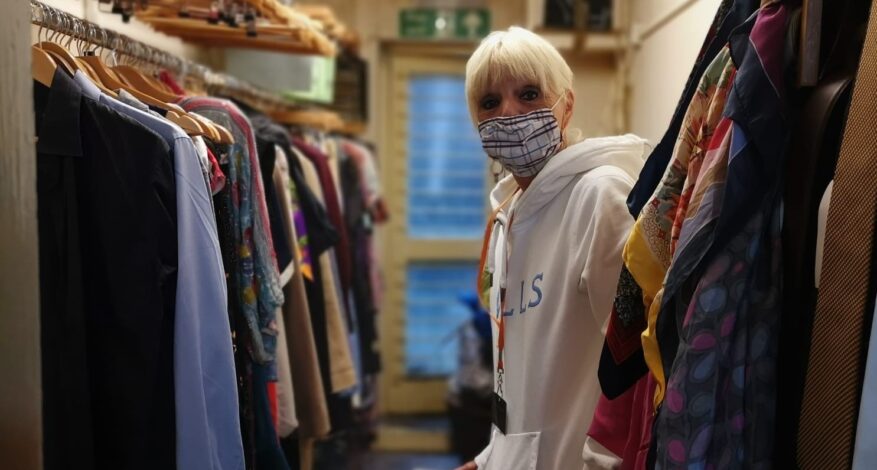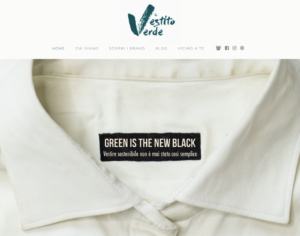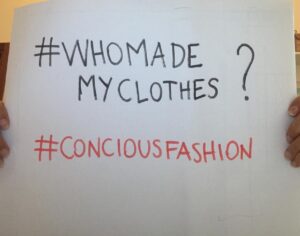DO YOU KNOW WHAT TO WEAR?
Fast-fashion convenience
How common is it for teenagers today to spend the afternoon shopping with friends? Why are some jeans they buy 20€, while other pairs cost much more? Aren’t they all jeans after all?
The answers to these questions and their explanations may not be neither encouraging nor easy as one may think. On average, teenage girls buy at least a piece of clothing every two weeks, and the majority of these pieces come from fast-fashion brands, which sell their products in most of the countries around the world. Their prices are low, and their garments always follow the latest fashion trends. Therefore, it is clear that buying in these kinds of shops is more convenient: they are cheaper, fashionable and easy to find wherever you are!
 However, the price of what we buy reflects the cost of its production, whether it is food, a piece of clothing, or a book. This includes the cost of both the human and natural resources needed to produce the item, of its production process, the manufacturing, transportation, and distribution. This means that lower prices are a reflection of cheaper factors of production. Consequently, the particularly low prices fast-fashion chains offer are economically sustainable for the brands because these firms do not face high costs of manufacturing or production. This is due to their own choices of production. These firms, in fact, often choose to produce abroad, in third world countries where the labor is cheaper than in their home country, and where environmental regulations are not as strict as they are in their home countries. Actually, in many cases, there is no environmental regulation at all in the countries where these firms choose to produce their clothing.
However, the price of what we buy reflects the cost of its production, whether it is food, a piece of clothing, or a book. This includes the cost of both the human and natural resources needed to produce the item, of its production process, the manufacturing, transportation, and distribution. This means that lower prices are a reflection of cheaper factors of production. Consequently, the particularly low prices fast-fashion chains offer are economically sustainable for the brands because these firms do not face high costs of manufacturing or production. This is due to their own choices of production. These firms, in fact, often choose to produce abroad, in third world countries where the labor is cheaper than in their home country, and where environmental regulations are not as strict as they are in their home countries. Actually, in many cases, there is no environmental regulation at all in the countries where these firms choose to produce their clothing.
Choices
 In 2017, a well-known international fast-fashion brand was in the spotlight of international press and media for some help-requesting messages found in the clothes some customers were buying. Unfortunately, this is not something uncommon. There are studies and investigations that show that many fast-fashion brands exploit minors in their production plants, as well as the absence of labor regulations in the countries where they produce. This is possible because they choose to produce in countries where there is no legislation that makes their behavior unlawful. Their choice of producing abroad for lower labor costs is common for many Multinational Enterprises of all kinds. Furthermore, there is proof that some of these firms allow production in very particular plants in China. As a matter of fact, some international investigation commissions have found out that, in many of these plants, there are only Uighur people working. This is a Turkic minority that is disliked and oppressed by the Chinese government. Apparently, after their work shifts, they have to go to schools where they are taught to sing the national Chinese anthem, where they learn about Chinese culture, literature, history, and traditions, in the hope that they will, in so doing, forget or even repudiate theirs owns.
In 2017, a well-known international fast-fashion brand was in the spotlight of international press and media for some help-requesting messages found in the clothes some customers were buying. Unfortunately, this is not something uncommon. There are studies and investigations that show that many fast-fashion brands exploit minors in their production plants, as well as the absence of labor regulations in the countries where they produce. This is possible because they choose to produce in countries where there is no legislation that makes their behavior unlawful. Their choice of producing abroad for lower labor costs is common for many Multinational Enterprises of all kinds. Furthermore, there is proof that some of these firms allow production in very particular plants in China. As a matter of fact, some international investigation commissions have found out that, in many of these plants, there are only Uighur people working. This is a Turkic minority that is disliked and oppressed by the Chinese government. Apparently, after their work shifts, they have to go to schools where they are taught to sing the national Chinese anthem, where they learn about Chinese culture, literature, history, and traditions, in the hope that they will, in so doing, forget or even repudiate theirs owns.
After years and years of such unfair exploiting practices, international legislators and policymakers have started to call for the approval of some rules of behavior for enterprises that choose to produce abroad. Now, they have some standards to meet in terms of labor retributions, and of environmental impact. In fact, this is the reason why many enterprises of this kind chose to move their production abroad in the past, in order not to face stricter environmental rules. Indeed, some developing countries refused to join international conventions on greenhouse emissions, waste disposal, or the use of certain methods of production and resource-extraction that are hurtful for our planet. Often, the claim of these countries is that they want to have the same possibilities and means of economic growth developed countries have had in the past, including methods that have been proved extremely dangerous and hurtful for the environment. In fact, adopting sustainable production methods is costly: to do so some firms have to re-convert the methods they have been using, by also investing in new machineries and labor able to apply these new methods. As both these changes are very expensive for the firms, many of them choose to follow the easier path – the cheapest one namely. They prefer to move their production to countries where these changes are not enforced. Data have shown that the water wasted by fast fashion companies to produce their items could quench the thirst of 5 Million people that do not normally have access to clean water. Furthermore, sustainable waste disposal procedures are usually more expensive than those based on environmentally hurtful methods. Besides, it is worth reminding that transporting the items made in third world countries usually requires planes, or long road trips with trucks and vans, which all cause, as many of you may know, high levels of air pollution due to the emissions.
How to get away from fast-fashion
 Not all hope is lost though. Fortunately, there are some simple habits we can get into to help fight environmental damage and labor exploitation in third-world countries. That is choosing more sustainable forms of fashion. Firstly, second-hand shopping is one of the most valid options. By buying used clothes we avoid the disposal of them, and this is amazing in terms of environmental sustainability. The disposal of textile fabrics, in fact, is very hard to make: it requires many chemicals and implies the emission of a great number of greenhouse gases into the atmosphere. Furthermore, disposing of used clothes in the environment instead of throwing them away is even worse. Indeed, textile fabrics are among the slowest materials to decompose, thus causing high levels of pollution. Last but not least, vintage is trendy today! So why not browsing our parents’ wardrobe with our friends, instead of the fast-fashion shops downtown? It is cheaper and better for all of us.
Not all hope is lost though. Fortunately, there are some simple habits we can get into to help fight environmental damage and labor exploitation in third-world countries. That is choosing more sustainable forms of fashion. Firstly, second-hand shopping is one of the most valid options. By buying used clothes we avoid the disposal of them, and this is amazing in terms of environmental sustainability. The disposal of textile fabrics, in fact, is very hard to make: it requires many chemicals and implies the emission of a great number of greenhouse gases into the atmosphere. Furthermore, disposing of used clothes in the environment instead of throwing them away is even worse. Indeed, textile fabrics are among the slowest materials to decompose, thus causing high levels of pollution. Last but not least, vintage is trendy today! So why not browsing our parents’ wardrobe with our friends, instead of the fast-fashion shops downtown? It is cheaper and better for all of us.
Another possible way to avoid the bad externalities of fast fashion is choosing the brands from which we buy more wisely. Buying clothes produced in your own country makes you more aware of the labor conditions in which the workers sew them. Lastly, the app Good On You does a great job in helping you to find brands that are more sustainable in terms of environmental impact, labor conditions, and animal rights. It will suggest valid and affordable alternatives to the brands you would commonly wear.
Make you choice
“Fast fashion is today commonly described as cheap, trendy clothing that samples ideas from the catwalk or celebrity culture and turns them into garments in high street stores at breakneck speed to meet consumer demand”.
Do you care enough to decide not to wear this kind of clothing?



